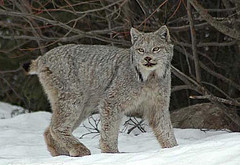Intensive agriculture, done secretly in forests, has a big impact on wildlife such as fishers.
Category Archives: predators
Lynx and Bobcat in Northeast
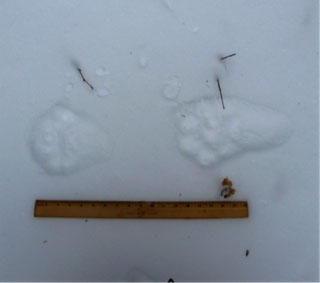 There are lynx sightings in Vermont and a new bobcat management plan in New York.
There are lynx sightings in Vermont and a new bobcat management plan in New York.
In New York, the bobcat management plan offers a road map for managing the species over the next five years. Bobcat numbers in the state are up, the report says:
All indications, including harvest trends, suggest that bobcats have increased in abundance here and in surrounding states, and observations have become more common in recent years. Based on analysis of harvest data, we estimate New York’s bobcat population to be approximately 5,000 animals in areas where regulated hunting and trapping seasons have been in place since the 1970s. Estimates are not available for populations expanding into western and central New York.
Because of this, the plan includes opening some new areas of the state to bobcat hunting and changing the bobcat hunting season in other areas for the sake of consistency. The report also mentions investigating the possibility of reestablishing bobcats on Long Island, in the urban southeast corner of the state.
In Vermont, it’s the rural northwest corner of the state that is seeing an increase of lynx sightings, according to the blog of the US Fish and Wildlife Service’s Northeast Ecological Services.
A total of eight lynx track intercepts were recorded during two survey efforts in February and March. The track patterns and genetic analysis indicated three to five distinct individuals, some of which were traveling together.
The animals traveling together were likely a mother and her young, the blog says, which suggests a breeding population in the area.
Read the entire blog post, here.
Photo: Lynx track, courtesy Vermont Fish and Wildlife Department
Considering their deep-forest habitat, fishers should be safe from rodenticides, but this study shows how urban environmental problems were brought into the wilderness.
Considering their deep-forest habitat, fishers should be safe from rodenticides, but this study shows how urban environmental problems were brought into the wilderness.
Role of Predators in Ecosystem Balance
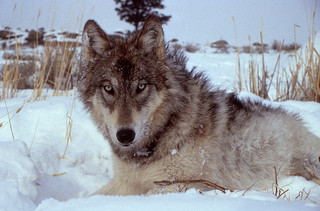 Do wolves and other large predators keep deer and other large herbivore populations in check, or is the food supply that really limits the herbivore population?
Do wolves and other large predators keep deer and other large herbivore populations in check, or is the food supply that really limits the herbivore population?
Two Oregon State University biologists did a meta-analysis of 42 published studies and found that large predators play a huge role in keeping ecosystems in balance. The analysis spanned North America and Eurasia, which may be why the study was published in the European Journal of Wildlife Research.
But it’s not a single predator alone that keeps the herbivores at levels that allow for a healthy mix of plants to grow, the paper also says. When an ecosystem hosts at least two large predators — such as wolves and bears, or wolves and lynx — each predator has an impact on a different part of its prey’s life cycle, reducing the population more than one alone.
Read the article in the European Journal of Wildlife Research, here. (Fee or subscription required.)
Or here.
Read an article from the Environmental News Service, here.
The OSU press release is here.
Photo: Yellowstone wolf, courtesy of Oregon State University
More States Turning to Night Hunting for Problem Animals
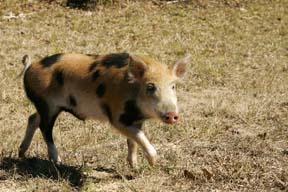 North Carolina, Arizona and Tennessee are among the states that are allowing night hunting for problem species like feral swine, coyotes and mountain lions when existing hunting practices fail to reduce populations, says an article in USA Today.
North Carolina, Arizona and Tennessee are among the states that are allowing night hunting for problem species like feral swine, coyotes and mountain lions when existing hunting practices fail to reduce populations, says an article in USA Today.
Night hunting is allowed in 42 states, the article says, quoting data from the Indiana-based National Predator Hunters Association.
In the article, a coyote coexistence advocate is quoted as saying that hunting does little to reduce population levels of the fecund coyote. That’s a sentiment shared by many wildlife managers was well, regarding both coyotes and feral swine.
Photo: Feral swine piglet. If only they were all this cute. By Steve Hillebrand, courtesy US Fish and Wildlife Service
Scent Marking Won’t Keep Coyotes Away
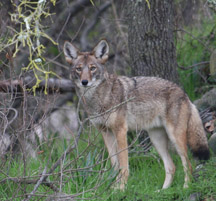 Coyotes are territorial and mark their territories with urine. There are plenty of studies that show predator urine keeps prey away (such as keeping deer away from a garden with coyote urine). And using territorial marking has worked in repelling African wild dogs. But the trick doesn’t appear to work with coyotes.
Coyotes are territorial and mark their territories with urine. There are plenty of studies that show predator urine keeps prey away (such as keeping deer away from a garden with coyote urine). And using territorial marking has worked in repelling African wild dogs. But the trick doesn’t appear to work with coyotes.
A study reported in the last issue of The Wildlife Society Bulletin found that using coyote urine to mark off an area to keep other coyotes away, not only didn’t repel them, but only served to have coyotes linger in the area.
Read the article in Wildlife Society Bulletin. (Subscription of fee required, but the abstract pretty much tells you all you need to know.)
A Ph.D. student of that paper’s lead author did a similar study a few years ago, with captive coyotes, and got a similar finding. Read her doctoral thesis, with references to the predator/prey studies and other background info on the general concept — here.
Coyote photo by Steve Thompson, courtesy US Fish and Wildlife Service
Writing the Book on Wolverines
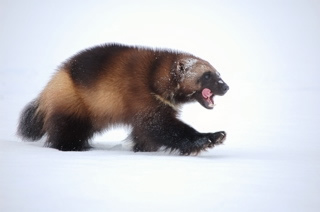 Before recent research on wolverines in the greater Yellowstone region, not much was known about these predators, says an article in the Billings Gazette. To wrap up the eight-year project, the article says, the research team, lead by Bob Inman of the Wildlife Conservation Society, has published an article in the Journal of Wildlife Management.
Before recent research on wolverines in the greater Yellowstone region, not much was known about these predators, says an article in the Billings Gazette. To wrap up the eight-year project, the article says, the research team, lead by Bob Inman of the Wildlife Conservation Society, has published an article in the Journal of Wildlife Management.
The article “Spacial ecology of wolverines at the southern periphery of distribution” was published online in December 2011. (Subscription or fee required.)
The Billings Gazette article implies that we’ll be seeing more research from this study published soon.
The Wolverine Blog (yes, there is one) offers a link to the blog of Forrest McCarthy, one of the researchers on the project. Read it for a behind-the-scenes view of the research, here.
Photo: Wolverine, Credit: Steve Kroschel, courtesy US Fish and Wildlife Service
Winter Research Roundup
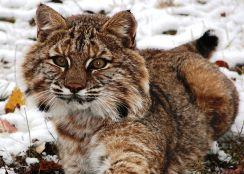 In New York State, a recent survey of the spruce grouse population revealed that there are not many of the birds left in that state. A revised management plan seeks to restore the population.
In New York State, a recent survey of the spruce grouse population revealed that there are not many of the birds left in that state. A revised management plan seeks to restore the population.
An Albany Times-Union article about the survey and results
A link to download the spruce grouse management plan.
New York State has also released a management plan for bobcats. The plan includes a survey of the state’s current bobcat population. Comments on the plan are being accepted until February 16.
Read an article about the plan in North Country News, here.
Here’s the state’s bobcat page, with a link to the management plan.
In California, the Department of Fish and Game is looking for volunteers over 16 years old and in good health to help count bighorn sheep in the San Gabriel Mountains on March 4. There is an orientation on March 3.
Read an article from KPPC, southern California public radio, here.
Go to a website dedicated to the count, here.
Also in California, the US Fish and Wildlife Service will review the status of the San Bernardino flying squirrel. It’s soliciting information about the flying squirrel and its habitat from state and federal natural resource agencies until April 2.
Read the article in the Riverside Press-Enterprise
The US Fish and Wildlife service press release is here.
Bobcat photo courtesy of the New York State Department of Environmental Conservation.
To Bring Back Lynx, Bring Back Wolves
A paper in the current issue of the Wildlife Society Bulletin says that when gray wolves are removed from an ecosystem, Canada lynx populations take a double blow. One blow comes when elk and deer populations explode and eat all the shrubs. That leaves the lynx’s prey, the snowshoe hare, with nothing to eat and no where to hide.
The other blow is that without wolves maintaining the “ecology of fear,” coyote populations also increase. And while coyotes will eat anything, they really like to eat rabbits, hares and other creatures of that size. In places where deep snow pack does not keep the coyotes away, lynx can find themselves with little to eat.
Yes, this is yet another example of mesopredator release, but as the pithy Science news article (subscription required) points out, in Canada they have both wolves and lynx. In the U.S. there are places without wolves where lynx have suffered a mysterious decline. It will be interesting to see what happens to lynx populations in places with growing wolf populations.
Read the Oregon State University press release here.
Read an article in the Minneapolis Star Tribune here. And here’s a write-up from the East Oregonian.
Photo: Canada lynx, courtesy of Oregon State University

